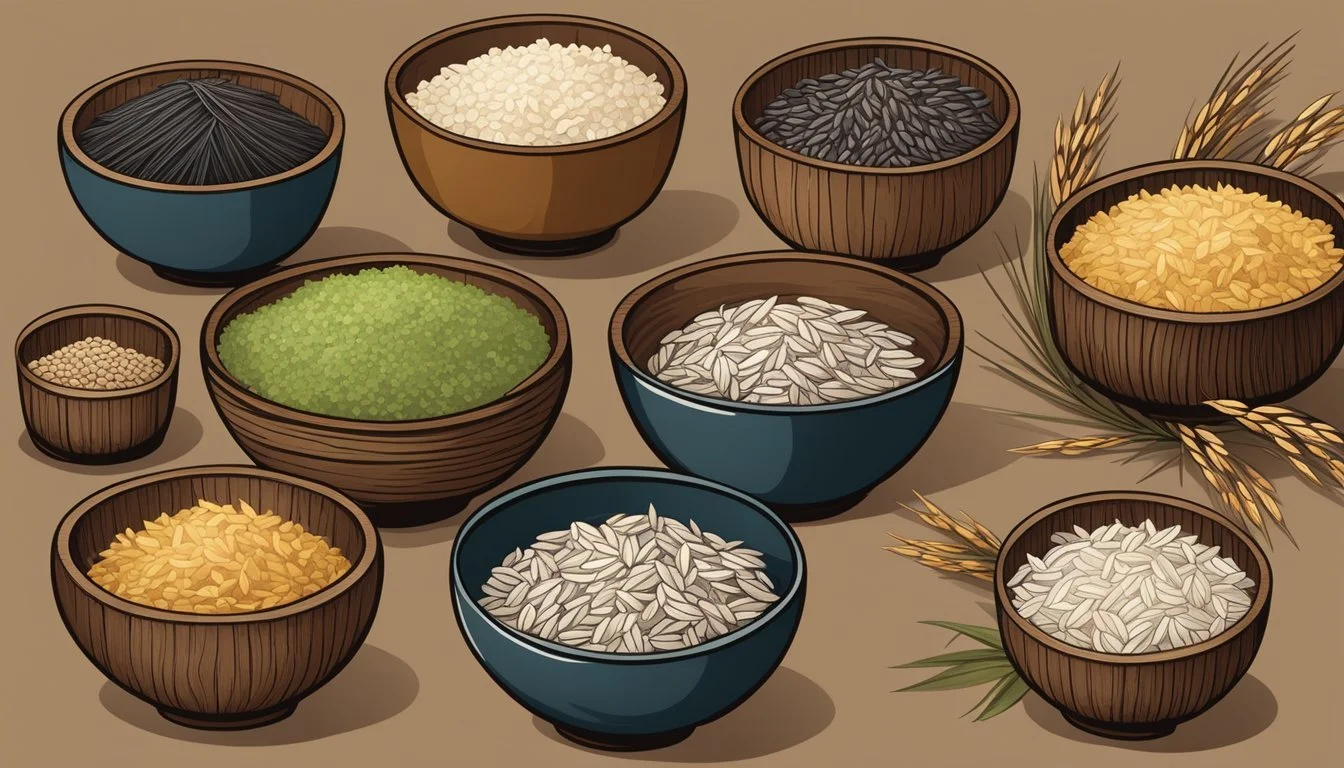Wild Rice Substitutes
Best Alternatives for Healthy Cooking
Finding a suitable substitute for wild rice can transform your dish while retaining its desired health benefits. Brown Basmati rice is one excellent alternative, offering a nutty flavor and chewy texture similar to wild rice. It's also rich in essential nutrients, making it a healthy and delicious option.
Another great substitute is barley, which brings a hearty, pasta-like texture and a rich, nutty flavor to your meals. Additionally, barley is a nutrient-rich grain particularly abundant in fiber, helping to lower cholesterol and blood sugar levels.
For those seeking gluten-free options, quinoa and buckwheat stand out. Both provide a robust nutritional profile with high protein content, making them excellent whole-grain substitutes for wild rice. They blend well with various dishes while promoting better health.
Understanding Wild Rice
Wild rice, an ancient grain, is known for its unique nutritional profile and distinctive characteristics, including its chewy texture and nutty flavor.
Nutritional Profile
Wild rice offers an impressive array of vitamins and minerals. It is especially rich in B vitamins, such as niacin, riboflavin, and folate. These nutrients are essential for energy production and cellular function. Additionally, wild rice is high in fiber, which promotes digestive health and helps maintain stable blood sugar levels.
Protein content is substantial in wild rice, making it a suitable option for those seeking plant-based protein sources. A 1-cup serving provides about 7 grams of protein. Essential minerals such as magnesium, zinc, phosphorus, and iron are also present in significant amounts, supporting various bodily functions, from bone health to immune system support.
Distinctive Characteristics
One of the standout features of wild rice is its flavor and texture. It has a chewy texture that adds a delightful contrast to various dishes. The nutty flavor of wild rice sets it apart from other grains, making it a popular choice for recipes requiring a robust, earthy taste.
Wild rice also boasts a high level of antioxidants, which help protect the body against oxidative stress and inflammation. The unique combination of textures and flavors makes wild rice versatile in culinary applications, suitable for use in salads, soups, and pilafs.
Wild rice's distinctive character makes it a favored ingredient in both traditional and modern cuisines. Its ability to absorb and enhance surrounding flavors further elevates the overall taste profile of any dish it is added to.
Wild Rice in the Kitchen
Wild rice is enjoyed for its unique texture and nutty flavor, making it a popular choice in various dishes. Key uses include adding depth to side and main dishes, while preferred cooking methods focus on enhancing its natural characteristics.
Common Uses in Recipes
Wild rice is highly versatile, suitable for a variety of dishes. It can be used in side dishes like pilafs or as a base in salads. It pairs well with vegetables and nuts, adding a satisfying chewiness to recipes.
In main dishes, wild rice features prominently in soups such as creamy chicken soup or hearty stews. Its robust texture also makes it an excellent addition to casseroles and stuffings, providing a distinct contrast to softer ingredients.
Preferred Cooking Methods
Cooking wild rice typically involves boiling or steaming. The grain should be rinsed before cooking to remove any debris. Boil in a ratio of 3 parts water to 1 part wild rice, simmering for 45-60 minutes until tender.
To enhance flavor, broth can be used instead of water. For a unique twist, consider sautéing the wild rice briefly before boiling to add a slightly toasted flavor. This method brings out the nutty notes, augmenting the overall taste profile.
Choosing Wild Rice Substitutes
Selecting the best wild rice substitute involves understanding the key factors such as texture, flavor, and cooking time to ensure the replacement complements your dish well.
Criteria for Substitution
When looking for wild rice substitutes, texture and flavor are primary considerations. Wild rice has a unique chewy texture and nutty flavor, making it essential to find grains that offer similar qualities.
The nutritional profile is another important aspect. Wild rice is high in protein, fiber, and essential minerals, so choosing substitutes like quinoa or barley can help maintain nutritional balance.
Cooking time also plays a role. Wild rice typically takes about 45 minutes to cook, whereas substitutes like brown rice or farro may vary. Flavor compatibility is key to ensuring that the substitute integrates well with other ingredients in the recipe.
Top Wild Rice Substitutes
Brown Rice: Brown rice is a versatile substitute with a slightly chewy texture and mild flavor. It takes around 45 minutes to cook, making it a practical alternative. Its nutritional profile is rich in fiber and protein, similar to wild rice.
Quinoa: Quinoa offers a different texture but absorbs flavors well. It cooks quickly in 15-20 minutes and provides a high protein content, making it a nutritious option. Fluff it with a fork post-cooking for the best results.
Basmati Rice: Both brown and white basmati rice serve as convenient substitutes. They have a lighter texture but can complement many dishes where wild rice is typically used. Basmati rice is widely available and cooks in about 20-25 minutes.
Barley: Barley is nutrient-rich and has a hearty, nutty flavor. Its chewy texture makes it similar to wild rice. Barley is particularly high in fiber, especially beta-glucan, which can help lower cholesterol.
Farro: Farro is another excellent substitute with a firm and chewy texture. It has a slightly nutty flavor and is packed with nutrients, including fiber and protein. Farro cooks in about 30 minutes and pairs well with various dishes.
Black Rice: Black rice, sometimes called forbidden rice, is visually striking and offers a slightly sweet, nutty flavor. It is rich in antioxidants and similar to wild rice in nutritional content, taking about 30-35 minutes to cook.
Specialty Substitutes and Alternatives
For those seeking alternatives to wild rice, options exist that not only accommodate dietary needs like gluten intolerance but also provide high nutritional value.
Gluten-Free Alternatives
Quinoa emerges as a top choice for gluten-free requirements. This pseudo-grain is not just free from gluten but also offers a complete protein profile, containing all nine essential amino acids. Quinoa's texture is light and fluffy, making it suitable for various dishes from salads to side dishes. Additionally, it has high fiber content, which aids in digestion and can help maintain stable blood sugar levels.
Cauliflower rice offers another gluten-free substitute. Made by finely chopping cauliflower until it mimics the size of rice grains, this alternative is low in calories and carbohydrates. It's an excellent option for those looking to reduce their carbohydrate intake. Rich in vitamins C and K, cauliflower rice can be quickly sautéed, steamed, or eaten raw, adding versatility to meal preparation.
Nutrient-Dense Replacements
Millet stands out as a nutrient-dense substitute. Known for its high protein and fiber content, millet is also rich in B-vitamins, iron, and magnesium. This grain possesses a subtle, nutty flavor, which fits well in dishes like pilafs and casseroles, while its high fiber content promotes gastrointestinal health.
Lentils are another excellent option, known for their high protein and fiber content. Unlike traditional cereals and grains, lentils are legumes that provide substantial amounts of essential amino acids and other nutrients such as iron and folate. When used as a wild rice substitute, lentils bring a hearty, earthy taste and maintain a firm texture, making them perfect for soups and stews.
Health and Dietary Considerations
Substituting wild rice can have various health and dietary implications. Alternatives like brown rice, quinoa, farro, and barley each come with unique nutritional benefits tailored to different dietary needs.
Wild Rice for Special Diets
Wild rice is suitable for vegan and vegetarian diets due to its plant-based origins and high protein content. It is a valuable option for those seeking to manage their weight since it is low in calories and rich in fiber, which promotes satiety. Additionally, wild rice has a low glycemic index, making it suitable for individuals managing blood sugar levels. This natural grain also supports heart health by helping to manage cholesterol levels through its fiber content.
Managing Health Concerns
Substitutes like quinoa and barley offer numerous health benefits. Quinoa is packed with essential nutrients, including fiber, protein, and complex carbohydrates, making it a great choice for weight management and improving digestion. Barley is noted for its high fiber content, particularly beta-glucan, which can aid in lowering cholesterol and stabilizing blood sugar levels. Both grains are suitable for vegan and vegetarian diets, and they accommodate those looking for low-fat options while providing essential vitamins and minerals. For people with specific dietary needs, each substitute offers a diverse range of nutrients that support overall well-being.
Enhancing Flavors and Textures
In culinary preparations, herbs, spices, and additional ingredients can significantly enhance the flavors and textures of wild rice substitutes. Savory dishes benefit greatly from the right combinations, adding depth and complexity.
Herbs and Spices as Complements
When cooking wild rice substitutes like brown rice, barley, and quinoa, herbs and spices play a crucial role. Smoked paprika adds a hint of smoky flavor, perfect for savory dishes. Garlic and onions, essential aromatics, provide a robust base. Adding thyme or rosemary can impart earthy undertones, while parsley and cilantro offer freshness. For a bit of heat, crushed red pepper flakes or cayenne pepper work well.
Additionally, herbs de Provence mix, containing thyme, rosemary, and lavender, can elevate the taste profile with its unique combination. These herbs and spices not only enrich the flavor but also balance the natural nuttiness and texture of the grains.
Additional Ingredients for Complexity
To further enhance the complexity of dishes, incorporating additional ingredients is key. Mushrooms, with their umami qualities, pair well with grains like barley and quinoa. Sautéing them with onions and garlic deepens the dish's flavor. Nuts add a delightful crunch and richness; toasted almonds or walnuts are excellent choices.
Peppers, both sweet and hot, bring brightness and a pop of color. Red bell peppers can provide sweetness, while jalapeños introduce a mild spice. Adding dried fruits like cranberries or apricots can contrast the savory elements with a touch of sweetness. Lastly, a splash of citrus juice or zest can lighten and brighten the overall flavor, making the dish more vibrant and appealing.
Comparative Analysis
Wild rice has a unique flavor and nutritional profile. Understanding how it compares with other grains can help in choosing the best substitute for various culinary needs.
Wild Rice vs. Other Grains
Wild Rice: Wild rice is known for its earthy, nutty flavor and chewy texture. It’s not technically rice but rather the seed of an aquatic grass.
Brown Rice: Brown rice, including long grain brown rice, has a similar nutty flavor to wild rice. It is chewier than white rice and retains more nutrients due to its unpolished state.
White Rice: White rice, such as white basmati and jasmine, is softer and milder in flavor. It lacks the complex taste of wild rice and has fewer nutrients due to polishing which removes the bran layer.
Black Rice: Black rice is dense and has a slightly sweet flavor. It is often called forbidden rice and has higher levels of antioxidants compared to wild rice.
Other Grains: Barley, with its pasta-like texture, and quinoa, which has a fluffy texture, can also be good alternatives. Both have distinct flavors that can complement various dishes.
Nutritional Considerations
Protein and Essential Amino Acids: Wild rice contains higher protein levels compared to white rice and is rich in essential amino acids. Quinoa is notable among substitutes for its complete protein profile.
Fiber Content: Wild rice is high in fiber, aiding digestion. Barley and brown rice have comparable fiber content, making them good options for maintaining digestive health.
Vitamins and Minerals: Wild rice is abundant in B vitamins and minerals such as magnesium and zinc. Brown rice retains more vitamins and minerals compared to white rice, which loses nutrients during processing.
Calories: Wild rice is low in calories compared to many other grain options. For those looking to manage calorie intake, this can be an important factor.






